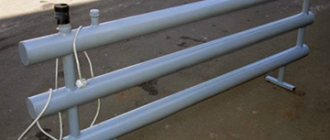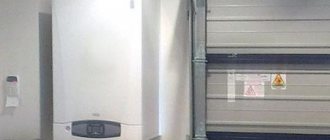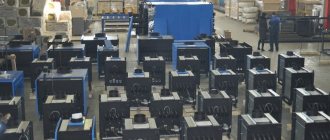Gas consumption in autonomous gasification systems for houses depends on many factors, the main ones being the following.
Desired temperature in the house
The value of the comfortable temperature in the house, the outside air temperature and the duration of the heating period directly affect gas consumption.
Areas of walls, windows, doors, ceilings and floors
For example, the larger the window area, the greater the heat loss and gas consumption of the boiler.
House design and materials
The thicker the walls, the better their thermal insulation properties. Heat loss through wooden walls is lower than through brick walls with equal thickness, and a double-glazed window provides greater energy efficiency compared to a single-chamber one.
Mode of residence and number of residents
You can live in the house permanently, or you can only come on weekends and holidays. The gas consumption for cooking and preparing hot water for the domestic hot water system depends on the number of residents.
Availability of a swimming pool
Heating pool water significantly increases gas consumption.
Other equipment
A gas generator, outdoor infrared heaters, etc. can be connected to the gas holder.
Gas consumption for heating
The consumption of liquefied gas during autonomous gasification of a private home plays, if not key, then very important importance in the eyes of homeowners when assessing the feasibility of ordering this important event.
The question of what the gas consumption from
a gas holder is for heating a house
and cooking can only be answered using some average indicators. And this is quite obvious, since the intensity of this process is influenced by a fairly wide range of factors.
These include the average annual climatic conditions of a particular area, the seasonality of the cottage’s operation, its heated area and the associated power of the heating equipment, the number of residents, the type and volume of the gas tank that determine the size of the evaporation surface, and others that can significantly adjust the rate of LPG consumption during autonomous gasification of a private house. in one direction or another.
Distance from home to gas tank
Note! The installation location of the device in question (distance from the house) is regulated by building codes and regulations.
According to experts, the distance from the house to the gas tank will depend on the size of the tank. In this case, the building codes stipulate the following requirements. For above-ground containers:
- With a gas tank volume of 5 m3, the minimum distance should be within 20 meters;
- From 5m3 to 10m3 – 30 meters;
- 10…20m3 – 40 meters.
How should a gas tank be located on a personal plot?
When installing a horizontal gas tank, provided that the tank is underground, the distances are reduced:
- For tanks with a volume of up to 10m3 up to 10 meters;
- For a gas tank 10… 20m3 – 15 meters;
- For gas storage larger than 20 m3 - at least 20 meters.
Gas consumption during autonomous gasification of a house: statistical method
As statistics show, the average gas consumption from a gas tank for the entire heating season is approximately 20 liters per meter of heated area of the house (with a total housing area of up to 200 square meters), based on a number of assumptions, in particular:
- The cottage insulation work was carried out in strict compliance with all GOST requirements;
- The calculated temperature in the cold season is taken as the average value for the northeastern regions of Russia;
- The influence of a number of factors - the material of the walls of the building, the wind rose, the amount and type of precipitation and others - was not taken into account in the calculation;
- The power of the boiler equipment is taken based on the condition of equality to the formula: heated area/10;
- The number of residents does not exceed 6 people, each of whom uses gas only for heating the premises, providing hot water supply and cooking;
- The average production of LPG from a gas tank for the entire heating season is approximately 20 liters per meter of heated area with a total housing area of up to 200 square meters. In the case of a larger area, the relative consumption of hydrocarbons per square meter will decrease
In the case of a larger room area, the relative consumption of hydrocarbons per square meter will decrease.
For example, let's calculate gas consumption
for a house of 100 m2 and 200 m2
.
Accessories
In this situation, it all depends on the price, type of model, and manufacturer. But even the purchase of expensive equipment does not guarantee that its components will include a complete set of all the necessary tools for comfortable work.
Here is a list of tools that you may need to comfortably use a laser machine.
- Case for transporting equipment.
- Protective glasses from laser light.
- Sighting targets.
- Laser receiver.
- Remote Control.
- Mount for the device.
- Tripod.
- Magnetic mounts for installing the device on a vertical plane.
- Additional battery.
Although a device such as a laser level is an expensive tool, its characteristics and capabilities easily pay for its cost, making work more comfortable, faster and more convenient.
Gas consumption per house 100 m2
Let's take a closer look at the need for heating in houses and year-round country cottages with a small area using a liquefied gas boiler.
The required volume of liquefied gas is calculated using the formula V = Q / q × B, where: V is the estimated amount of gas; Q – thermal power required for heating housing (taken at 5 kilowatts at a nominal 10 kW, since throughout the heating season the ambient temperature can vary widely, which allows saving on the rate of LPG production); q – calorific value of fuel, for liquefied gas it is assumed to be 12.8 kW/m; B – efficiency of the existing heating boiler in absolute value (that is, less than 1).
Thus, the gas consumption for a house of 100 m2, based on the given formula for a boiler with an efficiency of 93%, is:
V = 5 / 12.8×0.93 = 0.42 (kg/h).
Based on this, the daily gas consumption for heating a 100 m2 house is: 0.42×24 = 10.08 cubic meters.
Accordingly, the monthly consumption of liquefied hydrocarbons will be: 10.08 × 30 = 302.42 cubic meters of fuel.
Taking into account that a liter of liquefied hydrocarbons weighs 0.54 kg, then the hourly gas consumption for heating a house of 100 square meters of area will require 0.42 / 0.54 = 0.78 (l) of liquefied hydrocarbons.
Speaking in more tangible terms, per day the consumption of liquefied hydrocarbons for heating a 100 m2 house will be 18.7 liters, and per month – 561 liters.
Accordingly, knowing the duration of the heating season in your place of residence (5-6 months), you can rationally select a gas holder of the optimal volume, one or two refills of which will be enough for all the household and heating needs of the inhabitants of your cottage.
We calculate consumption based on boiler power
Calculating how much a gas heating boiler consumes per month based on its power is much easier than in the previous example, since in this case the reserves for ventilation and hot water supply have already been taken into account. To calculate, we find 50% of the boiler power, and then calculate the consumption per day, per month or for the entire period of heating operation.
For example, let's take a boiler with a design power of 24 kW. Half of this power, that is, the average heat consumption per hour, will be 12 kW. To further calculate fuel consumption per hour, the resulting figure must be divided by the specific calorific value of the fuel. In our example it turns out: 12÷9.3=1.3 m3/h.
Further calculations look like this:
- consumption per day - 12×24=288 kW or in gas volume - 1.3×24=31.2 m3;
- monthly consumption - 288×30=8640 kW or in terms of natural gas - 31.2×30=936 m3.
In this example, we did not teach 10% losses for boiler operation. Therefore, the total consumption of natural gas per month will be slightly more than 1000 m3 (1029.3 m3). This calculation example is much simpler than the previous one, but the general principle is similar.
Gas consumption per house 200 m2
Gas consumption for heating a house of 200 m2 is determined using similar methods. Autonomous gas heating of such an area with a long heating season will ultimately be characterized by the following production values of liquefied propane-butane:
- Hourly - 1.56 l;
- Daily – 37.4 l;
- Monthly (30 days) – 1222 l.
Taking into account the fact that the calculation of the minimum required level of “blue fuel” consumption for heating housing of a given area was given above, the optimal indicators of its required reserves and, accordingly, the costs of its acquisition are somewhat higher. They are determined from the indicators calculated with a reserve capacity of the heating boiler.
How to pay less
There are several ways to reduce fuel consumption and increase the efficiency of the system used to reduce payments. First of all, we recommend:
- Insulate the facility;
- Optimize consumption volumes by adjusting heating and other equipment;
- Contact specialists to properly design an autonomous system, taking into account the nuances of its operation.
You can find out more and order gasification services by contacting our company. We will provide consulting assistance on any issues.
What is the gas consumption for heating with a gas holder? Example
Example of liquefied gas consumption and total costs associated with the operation of an autonomous gas supply system for the heating season (6 months)
| House area 160 sq.m. | House area 350 sq.m. | |
| Heating equipment power, kW | 24 | 44 |
| Gas consumption, l | 3000 | 6650 |
| Gas cost | 14 | 14 |
| Total gas costs, rub | 42000 | 93100 |
There is no need to add the cost of ordering a gas station to these figures, because it is already taken into account in the gas tariff we offer. Thus, you can adequately assess the final cost of preparing for the heating season in the Moscow region.
Choosing a gas tank without mistakes, nuances, recommendations from experts
Do not use used, homemade or other containers that do not meet the standards.
To ensure a high level of safety, you must use only high-quality factory-made gas equipment. When purchasing, you need to make sure that there are certificates and official guarantees. The following facts also deserve attention:
- Sufficiently strong walls are made of steel 6-10 mm thick.
- Built-in stiffening ribs increase resistance to mechanical stress.
- The most inexpensive anti-corrosion layer, made from bitumen mastic, is less durable.
- Epoxy resin performs its functions for a long time. But such a coating can be damaged by impacts and temperature changes.
- You will have to pay more for the polymer layer. But such a coating remains sealed for many years, so in the end you will save money.
- Additional protection is provided using active and passive electrochemical technologies.
- It is better if all safety and shut-off valves are included as standard. In this case, these components are subject to the manufacturer's general warranties.
- In the underground version of installing a horizontal gas holder for a country house, additional heating can be eliminated.
If necessary, install a specialized evaporator
The diagram shows the components of the corresponding tank equipment (6). To monitor gas formation, use a sensor (8) installed in the neck. The signal from it (5) goes to the heating boiler (1). The liquid mixture of propane and butane (7) is heated by a coil, which is connected to the supply (9) and return (10) pipes. Antifreeze circulates through this circuit. The working mixture in a gaseous state (11) is supplied to consumers (2) through an open electromagnetic valve (3).
A hatch of sufficient width is useful for technological inspection
Standard operating rules provide for periodic removal of paraffins and other contaminants. A visual check of the condition of the seams is also necessary. These routine operations are performed at least once every 10 years.
Such supports provide reliable fastening. When purchasing, you need to make sure that you have such “paws” so as not to use dubious devices for fixing heavy containers.
Monitoring the actual level of LPG consumption in the autonomous gas supply system of a private home
Of course, in a real situation, the above gas consumption figures may change in one direction or another. To ensure control of the current level of liquefied gas in the tank (including the option of remote control), there is a special device - telemetry, various versions of which can also be purchased profitably from our company, both as part of equipping a gas tank purchased on a turnkey basis, or separately.
Current gas price
- Minimum order - 2000 l;
- In winter, gas delivery is carried out only if there are cleared access roads;
- If the distance from the gas carrier stopping place to the gas tank is more than 50 m, inform the manager about this at the time of order.
| Delivery region | Price of 1 liter of gas, rub. | Propane content, % | Manufacturer |
| Moscow and Moscow region | from 25 | 85 | GazProm Surgut |
Current cost of gas tanks
| Volume, cube | Heated room area | High pipes, rub.* | |
| SpetsGaz | 2,7 | up to 150 m2 | 175 000 |
| 5 | from 150 to 250 m2 | 220 000 | |
| 6,2 | from 250 to 350 m2 | 245 000 | |
| 6,6 | from 250 to 350 m2 | 250 000 | |
| 8,1 | from 350 to 450 m2 | 285 000 | |
| 9,1 | from 350 to 450 m2 | 345 000 | |
| 10 | from 450 to 650 m2 | 365 000 | |
| 12 | over 650 m2 | 440 000 | |
| Kadatec | 2,7 | up to 150 m2 | 175 000 |
| 3,8 | from 150 to 250 m2 | 200 000 | |
| 4,8 | from 150 to 250 m2 | 220 000 | |
| 5,7 | from 250 to 350 m2 | 245 000 | |
| 6,6 | from 250 to 350 m2 | 265 000 | |
| 9,1 | from 350 to 450 m2 | 355 000 | |
| 10 | more than 500 m2 | 385 000 | |
| 15 | more than 500 m2 | 575 000 |
* It is possible to additionally equip the gas tank with a neck. The cost of a high neck is 30,000 rubles.
Current cost of gasification
| Volume, cube | Heated room area | High pipes, rub.* | |
| SpetsGaz | 2,7 | up to 150 m2 | 220 000 |
| 5 | from 150 to 250 m2 | 265 000 | |
| 6,2 | from 250 to 350 m2 | 290 000 | |
| 6,6 | from 250 to 350 m2 | 295 000 | |
| 8,1 | from 350 to 450 m2 | 330 000 | |
| 9,1 | from 350 to 450 m2 | 390 000 | |
| 10 | from 450 to 650 m2 | 410 000 | |
| 12 | over 650 m2 | 485 000 | |
| Kadatec | 2,7 | up to 150 m2 | 220 000 |
| 3,8 | from 150 to 250 m2 | 245 000 | |
| 4,8 | from 150 to 250 m2 | 265 000 | |
| 5,7 | from 250 to 350 m2 | 290 000 | |
| 6,6 | from 250 to 350 m2 | 310 000 | |
| 9,1 | from 350 to 450 m2 | 400 000 | |
| 10 | more than 500 m2 | 430 000 | |
| 15 | more than 500 m2 | 620 000 |
* It is possible to additionally equip the gas tank with a neck. The cost of a high neck is 30,000 rubles.
Vertical and horizontal
Many owners of country houses, before buying a tank, try to understand which gas tank is better - vertical or horizontal. According to experts, the best option would be to purchase a horizontal gas tank, because such a device has a large area of gas evaporation - the performance of the system depends on this. Vertical type devices have a much smaller evaporation area, but the performance of the heating system can be increased by installing an additional device - an evaporator.
Vertical gas holder
As you can understand, vertical tanks occupy a minimum area on the site, so such devices should be used when there is a shortage of usable space. These gas tanks have small overall dimensions and high cost compared to analogues. In winter, these tanks need to be covered with a layer of thermal insulation, which will contribute to better functioning of the system.
Horizontal type gas holders are mounted in a pit on a concrete or reinforced concrete foundation. After securing these devices, it is necessary to paint over the cables or anchors on the foundation. Carrying out such operations increases the service life of the tank.
There is no need to insulate such a gas tank, because it will be covered with earth. The body of such a product is protected with special solutions based on epoxy resin, which prevents corrosion of the material during operation.
Installation of a horizontal type gas holder
The choice of gas holder will depend on the allocated area for the tank. If there is not enough space, choose the vertical type. The main advantage of such a container is considered to be uniform gas flow, but there is also a drawback - a small area of fuel evaporation. For normal operation of a vertical gas tank, heating or the installation of a thick layer of thermal insulation is necessary, and this is an additional expense. Vertical gas tanks operate more efficiently, and their body is well protected from corrosion.
Why can you hear splashing water in the container?
This can be heard in winter. Please know that this is not water, but the butane component of SPBT. At the slightest frost, butane stops being converted into a vapor fraction. It is this that “splashes” in the form of liquid inside.
Butane component of SPBT in a gas cylinder
In the warm season, this problem does not arise: almost all of the propane-butane mixture is used. In order to avoid this in cold weather, it is recommended that when filling the container, ask the gas station attendant about the availability of a passport for the SPBT used. This document must contain information that the mixture contains at least 80 percent propane, which changes from liquid to vapor in cold weather. If you use such a gas station, then there should be no problems.











